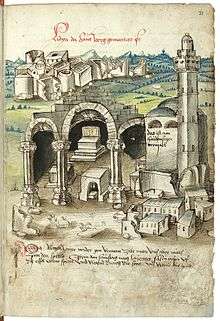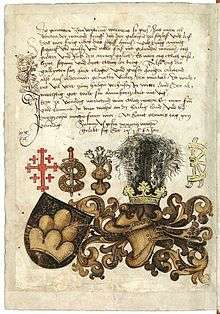Conrad Grünenberg


Conrad Grünenberg (also Konrad Grünemberg; d. 1494) was an inhabitant of Constance known for his armorial,[2] a chronicle containg coats-of-arms (Österreichische Wappenchronik, 1492?) and for the illustrated travelogue of his pilgrimage to Jerusalem in 1486 (extant in several manuscripts including Cod. St. Peter pap. 32 in Baden State Library).[3]
Grünenberg was perhaps born in the 1420s, as the son of the mayor of Constance. He is first mentioned in 1441 in the list of eldermen. By 1465, he had been in the service of emperor Frederick III for some time, and from 1485 or 1486 held the rank of Ritter. In Jerusalem, he apparently was made a Knight of the Holy Sepulchre. He was furthermore a member of the Order of the Jar and of the Austrian Order of Saint George.
His pilgrimage to the Holy Land lasted 33 weeks, from April to early December 1486. Starting out in Constance on 22 April, he travelled to Venice via Rheineck, Sterzing in Tyrol and Trento, and (31 May) from Venice by galley via Poreč, Zadar, Šibenik, Lesina, Korčula, Ragusa, Corfu, Modon in Morea, Candia in Crete, Rhodes, Famagusta in Cyprus, arriving in Jaffa on 24 July. Travelling by donkey he visited Lydda, Ramla, Emmaus (i.e. Imwas), Jerusalem and Bethlehem, and took a ship back from Jaffa on 1 September, reaching Venice on 16 November (Saint Othmar's day), returning home in early December.[4] The two earliest illustrated manuscripts describing the pilgrimage were completed very soon after his return to Constance and are claimed to be autograph.
References
- ↑ The half-wheel indicates a pilgrimage to Cyprus and Bethlehem, but not to Saint Catherine's Monastery in Sinai; display of the full wheel was reserved for pilgrims who had been to Sinai (Denke 2010:69–74).
- ↑ Extant in some ten manuscripts including Bayerische Staatsbibliothek Cgm 145, Cgm 9210.
- ↑ Konrad von Grünenberg: Beschreibung der Reise von Konstanz nach Jerusalem - Cod. St. Peter pap. 32
- ↑ Denke (2010:466)
- Andreas Klußmann, In Gottes Namen fahren wir. Die spätmittelalterlichen Pilgerberichte von Felix Fabri, Bernhard von Breydenbach und Konrad Grünemberg im Vergleich (2012).
- Christof Rolker, Konrad Grünenbergs Wappenbuch: acta et agenda, in: Zeitschrift für die Geschichte des Oberrheins 162 (2014), 191–207.
- Philipp Ruppert, Ritter Konrad Grünenberg, in: Konstanzer geschichtliche Beiträge. Zweites Heft, Konstanz 1890, 34–3
- Claudia Zrenner, Die Berichte der europäischen Jerusalempilger (1475-1500): ein literarischer Vergleich im historischen Kontext (1981).
- editions
- Stillfried-Alcantara, Hildebrandt, Des Conrad Grünenberg, Ritters und Burgers zu Costenz, Wappenbuch. Volbracht am nünden Tag des Abrellen do man zalt tusend vierhundert drü und achtzig jar. Görlitz 1875–1884, (new facsimile edition 2009)
- Johann Goldfriedrich, Walter Fränzel (eds.). Ritter Grünembergs Pilgerfahrt ins Heilige Land 1486, Leipzig 1912, (Voigtländers Quellenbücher 18), (new facsimile edition 2009).
- Kristian Aercke (ed.), The story of Sir Konrad Grünemberg's pilgrimage to the Holy Land in 1486 (2005).
- Andrea Denke, Konrad Grünembergs Pilgerreise ins Heilige Land 1486. Untersuchung, Edition und Kommentar (2010).
External links
| Wikimedia Commons has media related to Conrad Grünenberg. |
- Reginald Grünenberg: Ritter Conrad, mein Vater und ich (PDF; 225 kB), ^Die Welt 25 August 2009.
- Christof Rolker, The baron who became an architect: (mis-)remembering Konrad Grünenberg (d. 1494), 2017.